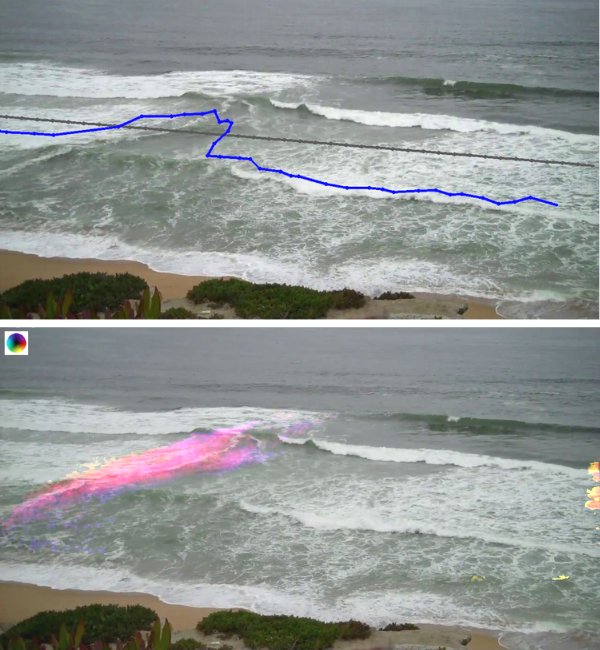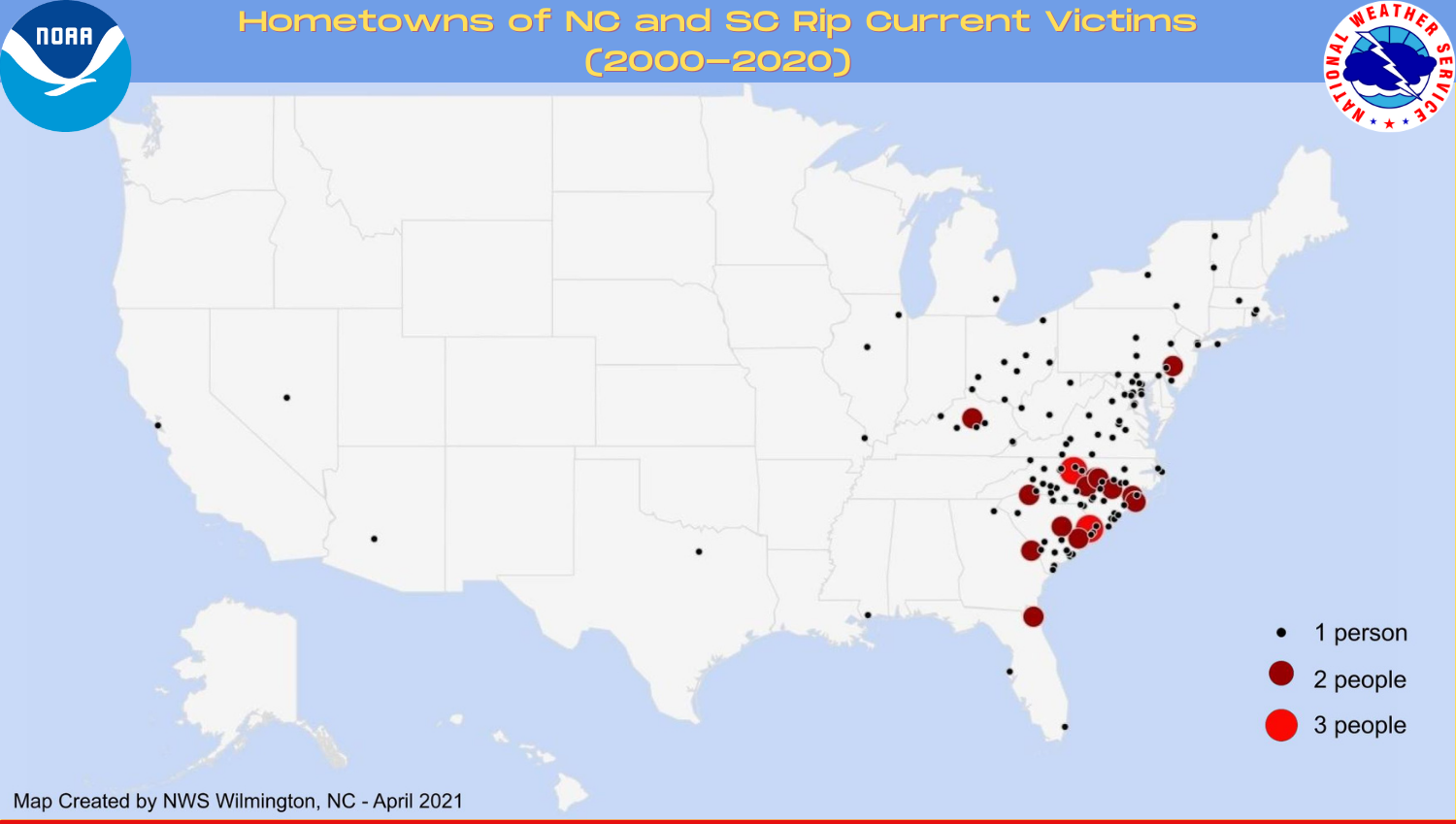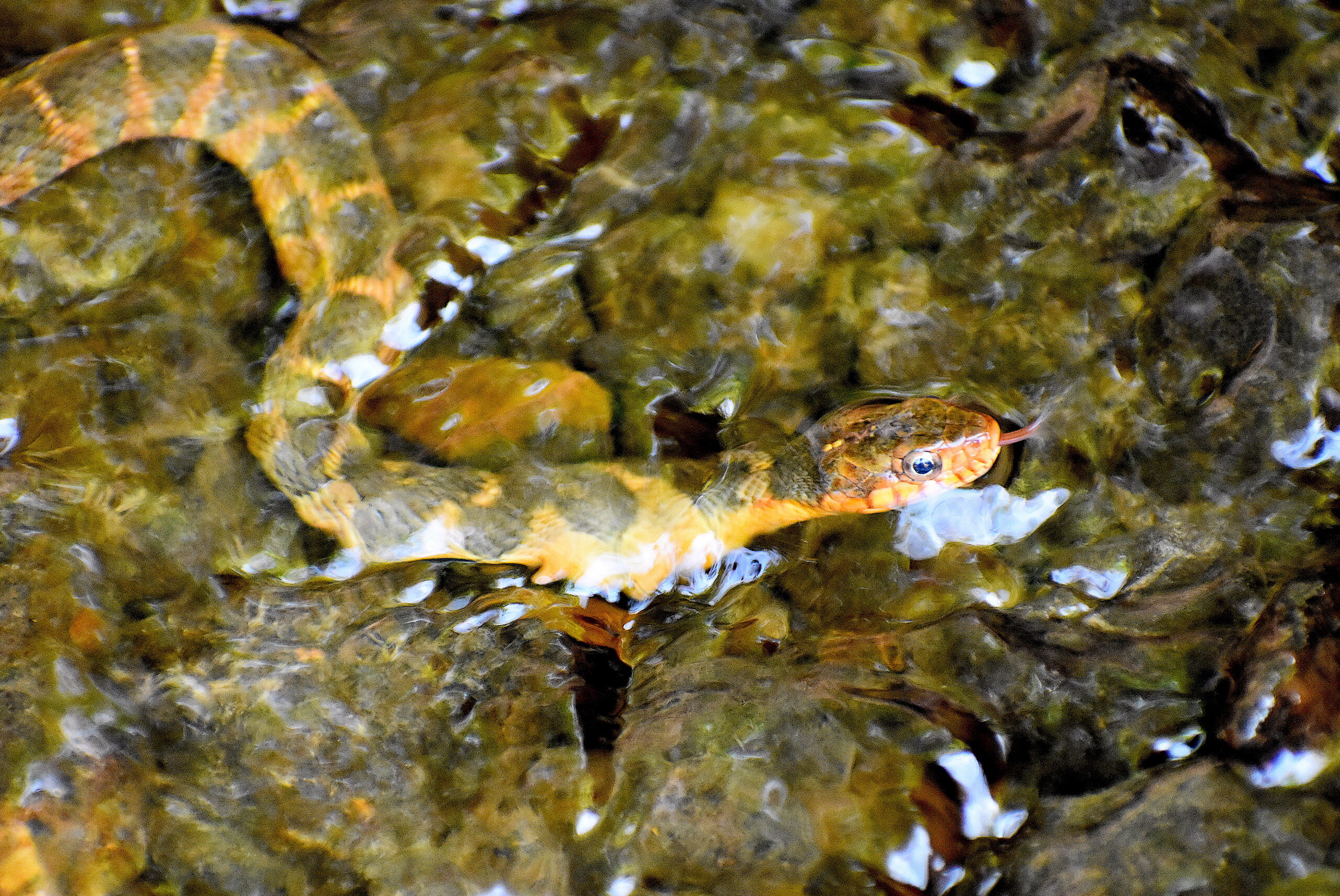Model Behavior
Drawing on lifeguard expertise and artificial intelligence, researches are improving rip current forecasting for beachgoers nationwide.

Several years ago in late September, Bob Schiffer rode his bike to the beach at Kill Devil Hills for a dip in the ocean, as he often did. Before heading to the water, he hung up his backpack on a pole with a waving red flag — a no-swimming alert indicating hazardous surf conditions. His plan was to repeatedly propel himself, porpoise-style, through shallow water, then backstroke to where he had started as part of a strength-building exercise he had practiced numerous times.
The sea was turbulent that day, with waves breaking in all directions, recalls Schiffer, who at the time lived on the Outer Banks. He had barely begun his routine when he suddenly discovered that he was nowhere close to the beach. “It happened as if I were on an express train,” he says, and “I realized I was in a rip” — that is, a narrow current of water flowing away from shore.

As a teenager growing up in New York City, Schiffer served as a beach lifeguard. He knew the common safety protocol: If you’re caught in a rip current, try to break free by swimming parallel to shore. Otherwise, float and call for help.
The churning water made swimming futile. Spying bystanders in the distance, Schiffer yelled for someone to call 911. Then he tried to relax, turning the face of his watch away from sight so he wouldn’t dwell on the time.
About 40 minutes later, help came splashing toward him. David Elder, lifeguard and supervisor of Kill Devil Hills Ocean Rescue, had received the distress call and arrived with a torpedo-shaped float. Schiffer grabbed hold and together they kicked back to shore.
The next day, the two ran into each other at a local café. Schiffer remembers wearing a rain slicker and that Elder pointed to its off-white interior, noting, “‘That’s the color of your complexion when I came to see you.’” In the ocean, treading water at what seemed like 50 yards from shore, Schiffer wasn’t aware of how drained he’d become.
Rip currents are the leading cause of death on surf beaches worldwide. Preliminary data collected by the National Weather Service suggests that in 2020, 65 rip-current related fatalities occurred in the United States and Puerto Rico. But that number doesn’t reflect unreported or undocumented drownings. (In this article, “drowning” implies fatality.)
Given that the majority of drownings occur on unguarded beaches or outside of regular beach patrol times, the actual U.S. death rate could be more than 100 a year, according to U.S. Lifesaving Association (USLA) executive director Chris Brewster and colleagues, reporting in Natural Hazards and Earth System Sciences in 2019.
This public safety threat has driven researchers to devise ways to predict hazardous rips. Until recently, efforts centered on a tool first pioneered in the 1990s, which National Weather Service forecasters have tailored to their locales. Just this past spring, the National Oceanic and Atmospheric Administration officially launched a new model designed to provide more precise and timely forecasts than ever before.
The tool combines lifeguard observations of rip currents and rescue reports with artificial intelligence to deliver an hourly forecast up to six days out for many U.S. coastlines — including in Hawaii, Puerto Rico, and Guam. Greg Dusek, NOAA senior scientist and project lead, says that with additional refining, forecasts will be available for the entire continental U.S., and even the Great Lakes, “hopefully not too far down the future.”
Ultimately, researchers aspire to warn swimmers of rip currents on their specific stretch of shore — in real time.
“Our long-term vision is that as a beachgoer points their smartphone at the beach, they will be alerted to locations where there are potential rips,” says Alex Pang, a computer scientist at UC Santa Cruz and a colleague of Dusek’s. In short, “we want to save lives.”
Wading In

Back in the early 2000s, lifeguard David Elder was becoming increasingly frustrated with the number of rip-related close calls and fatalities that his team was encountering. He wondered if there was a way to improve rip current forecasting, particularly for the sake of people on unguarded beaches.
“What I realized was the problem that we were experiencing was a lack of knowledge and an inability of the average patron to be able to understand what a rip current was,” says Elder, who has over 30 years of lifeguarding experience, and whose team has advanced certification from the USLA. “We need to inform them about [rips] in a more timely manner,” he adds — before they set foot on the sand.
Rip currents occur along beaches with breaking waves, including some Great Lakes shorelines. But their mere existence doesn’t spell danger. Speed is one key determinant. Many rip currents are so languid that swimmers won’t notice them. Others “can exceed the fastest Olympic swimmers at their worst,” says Spencer Rogers, North Carolina Sea Grant’s coastal erosion and construction specialist.
Lifeguards are expertly trained to spot dangerous rips — not by their speed, which is nearly impossible to detect with the naked eye — but by recognizing other signature traits, such as a narrow band of darker, seemingly calmer water between breaking waves on either side.
Guards also recognize when weather and ocean conditions have aligned such that rescues will be likely. “The really dangerous days are blue-sky, nice weather on the beach, with local wave-generating conditions that make high-velocity rip currents that are very, very dangerous,” says Rogers, who has served on a national rip current task force with NOAA, NWS, and USLA partners. “Those are the days where we have the most fatalities and the most rescues, because it doesn’t look threatening.”

The probability that a hazardous rip current will occur is what drives NOAA’s new forecasting tool. In other words, it hinges on the question, “How likely is this rip current to cause a swimmer distress?” says Dusek, who began the project as a Ph.D. student at the University of North Carolina at Chapel Hill.
Broadly speaking, three major factors contribute to rip current formation: wave conditions, tide, and the shape of the sea floor, or bathymetry. To build his model, Dusek had to figure out how to weight those factors such that their relationship predicted dangerous rips.
For help, he turned to Elder, who supplied him with a set of lifeguard observations and rescue reports from the summers of 2008 and 2009. Dusek then plugged historical ocean and weather data into the model to see how accurately it predicted hazardous rips reflected in the lifeguard data, tweaking the tool as necessary.
Using human observations — albeit ones rooted in expertise — to hone a computer model might raise eyebrows. “That kind of more qualitative observation, at first, could seem less powerful than a very quantitative speed measurement, but for the purposes of developing a hazard forecast, it’s actually perfect,” says Melissa Moulton, a coastal physical oceanographer at the University of Washington in the Applied Physics Laboratory and at the National Center for Atmospheric Research.
A few years ago, Moulton and Dusek tested the model against measurements that she and scientists from Woods Hole Oceanographic Institution had recorded with current meters submerged off the U.S. Army Corps of Engineers Field Research Facility in Duck. They wanted to see if the model predicted hazardous rips when the meters had recorded strong currents going offshore.
“We found that those totally different types of observations were remarkably consistent with each other,” she says. “I was really surprised how the lifeguard-derived hazard model and me, sticking a current meter in water, gave such a similar answer for the way that waves and tides control the presence of strong rip currents.” The team published their study in Weather and Forecasting in 2017.
Over time, Dusek and NOAA colleagues have improved the model with additional lifeguard observations from other beaches in and outside of North Carolina. Indeed, the suite of conditions that promote hazardous rip formation along our state’s barrier island shoreline aren’t identical to those along, say, rocky West Coast beaches. The model must crunch numbers differently depending on where it’s forecasting.
“The baseline model that we trained in North Carolina worked pretty well everywhere else we tested,” Dusek says, and yet “we can improve it dramatically if we have good observations in other places.”
Filling in Gaps
In March 2021, Dusek’s rip current model debuted as part of NOAA’s Nearshore Wave Prediction System, a tool that forecasts wave conditions, overwash, and erosion. The system seamlessly provides data for the rip model to make its predictions.
Many National Weather Service Forecast Offices are now using the new rip forecasts in conjunction with an older forecasting method to issue their rip guidance. The traditional method — which entails manually entering values for different weather and ocean conditions into a spreadsheet — has limitations for which the new model helps compensate, says Steve Pfaff, warning coordination meteorologist for the NWS Forecast Office in Wilmington.
“I think this is a great leap forward,” Pfaff says. For decades, forecasters have been “hamstrung, only able to provide a composite rip current risk for the beaches of an entire county.” The new model’s resolution enables meteorologists to home in on mile-long sections and provides hourly forecasts nearly a week in advance.
In addition, whereas the old method relied on a three-tier warning structure — low risk, moderate, or high — the new model provides a zero to 100% probability of hazardous rips occurring, similar to a rain forecast.

When Dusek and his doctoral advisor, Harvey Seim of UNC-Chapel Hill, first described the model in 2013 in the Journal of Coastal Research, they noted a 67% improvement over the old forecasting method for Kill Devil Hills. Since then, Dusek says, “pretty much everywhere we test, we see an improvement with the new approach, with obviously the added benefit [that] we’re not just giving you one value for today; we’re giving you much more information going much further into the future.”
“It’s really the first time we’ve had sophisticated numerical model guidance for rip currents that goes out that far and for that many beaches,” adds Mark Willis, Wilmington’s meteorologist in charge.
From a planning perspective, advance warning is crucial to emergency managers. Case in point: This past August, the University of North Carolina Wilmington was hosting an event on Wrightsville Beach, and the school’s emergency manager was concerned about the rip current risk.
Combining the old and new rip forecasting approaches, “we were able to say with a higher level of confidence, yes, there’s a moderate risk of rip currents for New Hanover County — in particular, Wrightsville Beach today — and we think that the rip probabilities will be highest during the morning,” Pfaff says.
On the Horizon
Despite years refining his model, Dusek acknowledges that “there’s still a lot of work to do.”
One important limitation is the tool’s treatment of bathymetry, a critical factor in rip current formation. For instance, channel rips can occur when a break between sandbars or reefs creates a conduit for water flowing back out to sea.
But capturing data on a constantly shifting sea floor is difficult, to say the least.
“What’s going on under the water, in the surf, is changing so fast and [is] so hard to measure,” says Moulton, the coastal physical oceanographer.
The rip model currently uses an approximation for bathymetry; specifically, it considers whether a big storm occurred several days prior to a given forecast. “From our research data we saw that, following a storm — you know, a pretty large wave event — the shape of the bottom would end up being pretty favorable to rip currents,” Dusek says.
Nor does the model yet account for the influence of structures, such as groins, jetties, and piers, which can promote rip currents as incoming waves deflect. Such structures can also influence how sediment moves and thereby affect bathymetry.
Dusek also plans to further improve the model using data beyond lifeguard observations. “Even though lifeguards are really good at doing this, there’s going to be different interpretations depending on where you are,” he says, “so a lifeguard in Kill Devil Hills, North Carolina, is probably going to see the beach differently than a lifeguard in San Diego, California.” Plus, most beaches don’t have guards, so many nearshore nuances go unobserved.

Dusek and colleagues think surf webcams — internet-connected cameras attached to stationary structures like piers — could provide missing data. The idea is that a camera would capture video of the surf, and a computer would analyze the imagery for tell-tale signs of dangerous rips. Positive identifications would then be used to enhance the rip current model.
Alex Pang of UC Santa Cruz is developing that technology using a process called machine learning; the team is testing its capability using footage from a regional array of webcams operated by the Southeast Coastal Ocean Observing Regional Association.
Dusek and Pang’s ultimate goal is to enable beachgoers to use their own smartphones to detect rip currents in real time. They envision docking stations located on elevated locations, such as piers and beach access points, where visitors can position their phones, open an app, and take steady footage of the shoreline in front of them. The app would then reveal dangerous rips with a virtual overlay marking their path, similar to Instagram filters that stick “whiskers and funny noses over someone’s selfie,” Pang says.
Pfaff says the concept is promising. Seeing a rip current illuminate on your phone “has a sense of realness to it,” he notes. “As far as an educational tool, I think that’s amazing.”
Getting the Message
The rip current that Bob Schiffer survived in Kill Devil Hills wasn’t his last. This past June, he and his daughter and grandson were playing in the surf at Ocean City, Maryland, when he discovered that he was again caught in a rip.
The prospect of drowning in front of loved ones filled Schiffer with anxiety, and he began frantically swimming. “Years of training and experience were erased by a flash of emotion,” he says.
Schiffer’s family escaped to shore, where his daughter immediately sought help. Once again, a lifeguard pulled him out of the water, shaken but unscathed.
In retrospect, Schiffer says he overlooked certain realities that likely contributed to the close call: He’s older, he hadn’t been in the ocean in a while, and, having once been a competitive swimmer, he fancied himself somewhat invincible.
Not everyone will experience such an epiphany. An enhanced rip current forecast is one step to saving more lives, but a prediction is only as good as the messaging around it. In that regard, building public awareness “has a long way to go,” says Pfaff.
Elder agrees. “How do you tell a 55-year-old male and a 19-year-old kid the same message? And where do you tell them that, and how do you say it?”
“This is something I’m passionate about,” Elder adds, “because I can see the faces in front of me, right now, who should have known this stuff and who will never get a chance to.” In North and South Carolina alone, more than 170 people have drowned in rip currents since 2000.
For Schiffer’s part, he’s changing his ways. “I’m accustomed to swimming alone, and was accustomed to swimming early before the beach opened,” he says. “I’ve now made a pact with my children, my daughters, that Grandpa will no longer do that, that I will abide by all of the reasonable standards.”

By the Numbers
Anyone can get caught in a rip current. The map above “highlights the need to talk about rip currents not only within coastal areas, but also in cities well inland, across the country,” says Victoria Oliva, a meteorologist with the NWS Forecast Office in Wilmington. “Whether someone lives in Greensboro, North Carolina, or Kentucky, if they ever visit a beach, they need to be aware of rip currents — what they are and how to stay safe.”
The Wilmington office provided the rip current-related statistics below. The data applies to North and South Carolina and extends from 2000 through July 31, 2021, except where noted.
- Known rip current deaths: 172 (141 males, 25 females, 6 whose gender was undocumented).
- Men ages 41 through 50 comprised the majority of male fatalities; women ages 31 through 40 constituted the majority of female fatalities.
- Most drownings occurred between noon and 5 p.m.
- 51% of deaths involved people visiting from outside North and South Carolina.
- Since 2010, 27% of fatalities have been considered “bystanders,” or people who entered the water in an attempt to rescue someone else in distress.
- 2013 saw a record 17 known rip current fatalities.
- In 2020, 11 known rip current drownings occurred.


